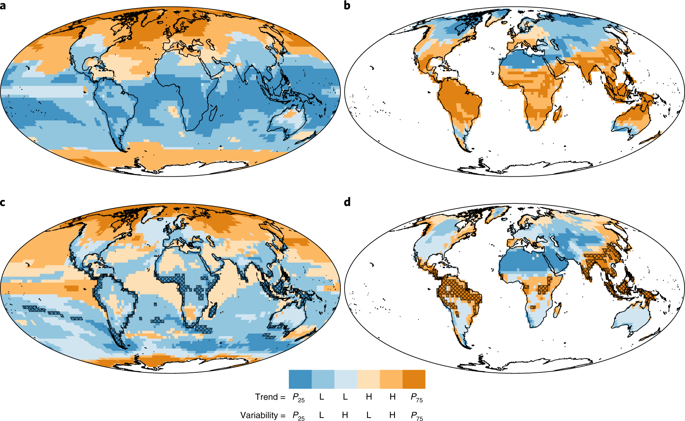Nature Climate Change ( IF 29.6 ) Pub Date : 2020-02-03 , DOI: 10.1038/s41558-019-0682-7 Stuart C. Brown , Tom M. L. Wigley , Bette L. Otto-Bliesner , Carsten Rahbek , Damien A. Fordham

|
Climate stability leads to high levels of speciation and reduced extinction rates, shaping species richness patterns1,2,3. Hotspots of species diversity often overlap with regions that experienced stable temperatures and, perhaps, variable rates of precipitation during the late Quaternary4,5. These hotspots potentially harbour many species with low vagility and small geographical ranges6, making them more vulnerable to future ecoclimatic change4,7,8. By comparing global and regional patterns of climate stability during short periods of unusually large and widespread climate changes since the Last Glacial Maximum with twenty-first-century patterns, we show that human-driven climate change will disproportionally affect biodiversity in late Quaternary climate refugia, ultimately affecting the species, communities and ecosystems that are most vulnerable to climate change. Moreover, future changes in absolute temperature will probably erode the mechanisms that are theorized to sustain biodiversity hotspots across time. These impending shifts from stable to unstable temperatures—projected for the majority of the world’s biodiversity regions—threaten to reduce the size and extent of important climatic safe havens for diversity. Where climate refugia are forecast to persist until the end of this century, temperatures in these refuges are likely to exceed the acclimation capacity of many species, making them short-term hospices for biodiversity at best7,8,9.
中文翻译:

持续的第四纪气候避难所是人类世生物多样性的收容所
气候稳定导致高水平的物种形成和降低的灭绝率,塑造物种丰富模式1,2,3。物种多样性的热点经常与经历稳定温度的地区重叠,也许在第四纪晚期4,5降水率变化。这些热点可能蕴藏着许多具有低波动性和小地理范围的物种6,使它们更容易受到未来生态气候变化的影响4,7,8. 通过将自末次盛冰期以来异常大且广泛的气候变化的短期内全球和区域气候稳定性模式与二十一世纪的模式进行比较,我们表明,人类驱动的气候变化将不成比例地影响晚第四纪气候避难所的生物多样性,最终影响最易受气候变化影响的物种、群落和生态系统。此外,未来绝对温度的变化可能会削弱理论上维持生物多样性热点的机制。这些即将发生的从稳定温度到不稳定温度的转变——世界上大多数生物多样性地区的预测——可能会减少重要的气候多样性避风港的规模和范围。7,8,9。










































 京公网安备 11010802027423号
京公网安备 11010802027423号